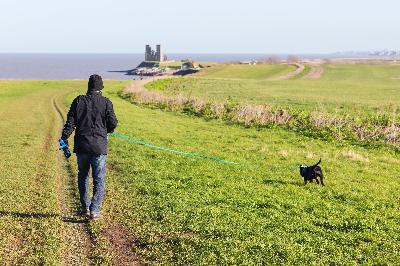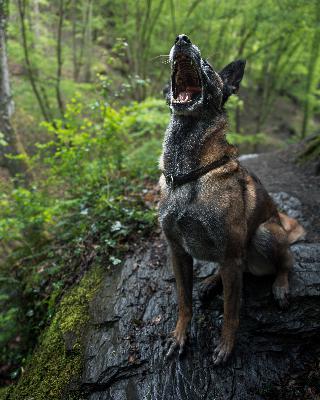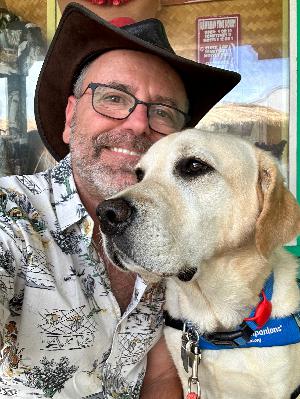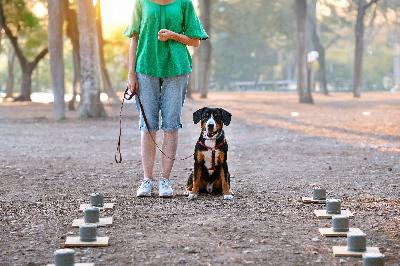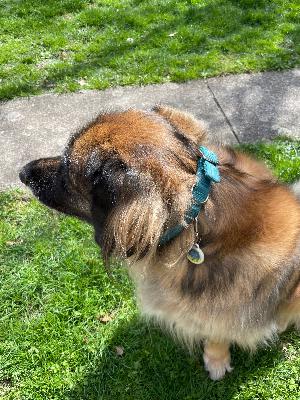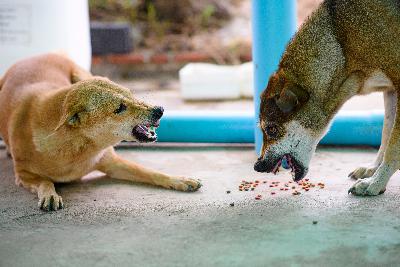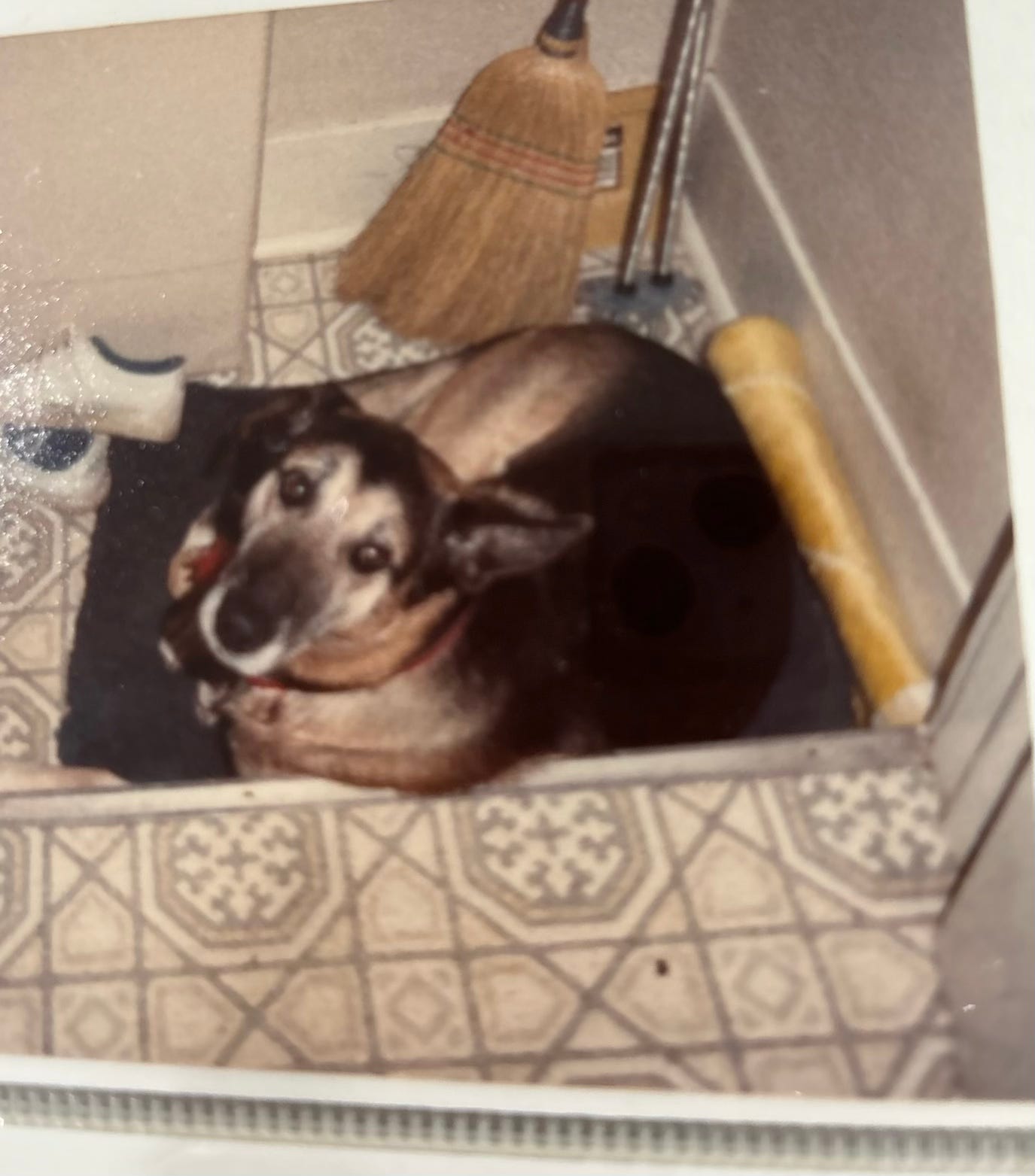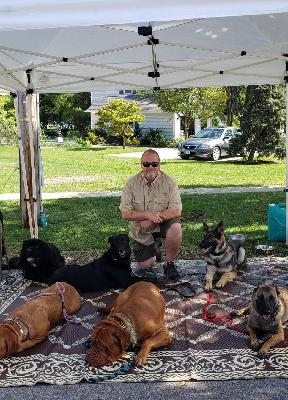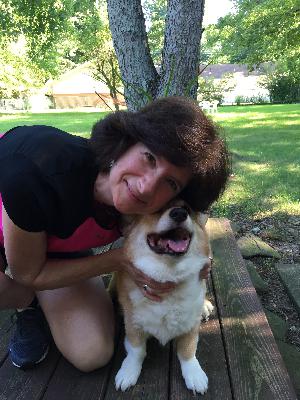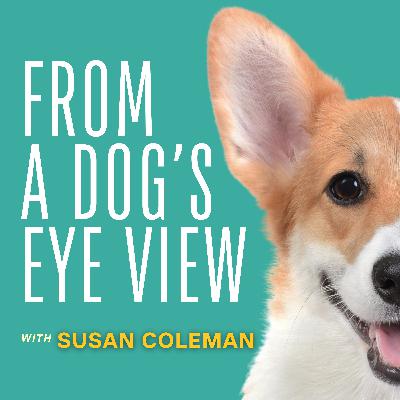The Walk
Description
In order to have a well-balanced dog, 60% of a dog's day should be filled with exercise, 20% discipline, and the other 20% affection, and in that order. This is according to Cesar Millan, a well known dog behaviorist. I agree with that, but I break that down a little bit more by saying that within that 60% exercise, 40% of it should be structured exercise. This refers to walking your dog in a structured way - more specifically, in a heel position. The dog should not be in front of you, behind you, or allowed to go wherever they want.
Another form of structured exercise is playing fetch or tug of war with your dog, but there has to be rules. When playing fetch, the dog must sit before you throw the ball. When the dog brings back the toy, you tell them to drop it, and then step in front of the toy to show that it belongs to you. This demonstrates you are the leader, making the rules of the game you are both engaged in. This also avoids the dog lunging at the toy at the same time as you, possibly avoiding an unintentional bite. After the dog retrieves the toy, you either engage in playing more fetch or you end the game.
If playing tug of war, the dog should be trained to release the toy on command. It is important to note that when you are playing tug of war with your dog, you are both competing for the same toy. They will see you as an equal until you set some rules from a position of leadership. Some dogs get over-the-top excited when playing this game, especially the terrier breeds, who are known to hold on at all costs!
In order to teach the dog to drop the toy, start with a light game of tug and trade the toy with a treat. At the same time the dog releases the toy from their mouth, say either “Release” or “Drop It”. They need to know what “Release” or “Drop It” means before escalating further with stronger tugging. This takes hundreds of repetitions. If you feel that your dog starts to get into a more aggressive state of mind, please contact me or a certified dog trainer for guidance.
The other 20% of a dog’s daily exercise can be unstructured exercise. This includes having free time in a fenced-in yard to wander around or to play with other dogs. Playing with another dog can totally exhaust a dog because there is the physical part of playing, but also the mental part of navigating how to communicate with the other dog. As dogs play with each other, they are communicating through their body language and movements. I always recommend that playtime be supervised in case any disagreements arise between the dogs.
Throughout the day, 20% of it should include discipline. This does not mean we are telling the dog “No!” every time they misbehave. It means that we are telling the dog where they can and cannot go. We are enforcing the rules of the house: what to do when guests arrive, if they are allowed on the furniture, or where they are allowed to sleep at night. This is where your basic obedience skills come in to play. For example, you may want the dog to sit and stay while you prepare his breakfast or dinner, or the dog must be in a down stay while your child or grandchild eats at the table.
The last 20% of a balanced dog’s day should be affection. The problem most of us have is that we give too much affection to our dogs at the wrong time. We unknowingly pet our dogs lovingly when the dog is in an excited or fearful state of mind. Remember, petting our dogs is a reward in the dog’s mind. You are rewarding the state of mind the dog is in at that moment. The best time to pet our dogs is when they are calm and submissive. We can be fooled by our dogs too. We may think they are calm because they are laying down. However, their brain may be in a tizzy still because they just finished playing and they haven’t calmed down yet. So, if you go to pet your dog and they get up and start getting excited all over again, then they aren’t totally calm and submissive. Just wait a few minutes for the brain to adjust to a calmer state and try again.
I believe that our dogs want us to be the leader and make decisions for them. Even in our human family, the parents should be enforcing the rules of the house. Otherwise, the children will feel they have to make their own decisions and they simply do not have the skillset to do so until they have matured into adolescence. Dogs are no different. Remember, they have the intelligence and insight of a 2 to 3 year old toddler. Dogs thrive when they know where to go and what to do in every situation, especially new scenarios. They need their leader to tell them.
I have found over the years working with clients, this 60% exercise, 20% discipline and 20% affection is lopsided. People are giving too much affection to their dogs, not enough discipline, and not enough exercise. Some people actually do exercise their dogs quite a bit, but it is mostly unstructured exercise. All of this can lead to unbalanced dogs who end up with various issues that get in the way of living harmoniously with their human family.
It is very challenging to keep up with our dogs. They have way more energy than we do. However, by keeping this 60-20-20 lifestyle with our dogs in the forefront of our minds, we are on our way to having a more balanced dog.
There are two different types of walks. One is a structured walk in the heel position and the other is a nature walk on a long leash, sometimes referred to as a “Sniffari”-a sniffing safari. The structured walk is what I recommend and teach all of my clients. This involves teaching the dog not to pull on the leash. It involves a mentality that the human is the leader and the dog is the follower. I am not opposed to a sniffari type of walk. Just make sure you are giving the dog permission to be at the end of the long leash instead of the dog making that decision. In fact, a sniffari type of walk can exhaust a dog due to the brain power expended from processing all of the scents on the walk. However, your everyday walks should include a structured walk to maintain a healthy leader-follower relationship.
Structured walks in the heel position require a lot of training and patience to accomplish. It doesn’t happen overnight. I haven’t met one person yet who enjoys being pulled on the leash by their dog. However, since it takes months and hundreds of repetitions to achieve a walk with no pulling, people tend to rush the process. So many people abandon walking their dog because of the danger of being pulled. Even those clients who do contact me for this reason, still won’t take the time necessary to teach the dog how to heel, and therefore still deal with being pulled on the leash.
The way I have had success in teaching a dog to heel is first finding the best walking tool for that dog. I go in to this in detail in my episode “Harnesses, Leashes and Collars, Oh My!”. After deciding on the right tool for the dog, choose which side you will predominantly walk your dog. It really doesn’t matter if the dog walks on the right or left hand side, unless you have plans to make your dog a show dog, a therapy dog, an AKC Canine Good Citizen, or enter competitive handling competitions. In these cases, it is highly recommended and even mandatory that the dog be walked on the left hand side.
As a trainer working with a pack of dogs, it is easier when everybody walks their dog on the left hand side. Some people may have physical limitations which may require the dog to be walked on the right hand side. However, as long as the dog is in the heel position, I can still manage the pack for certain obedience exercises.
After determining the right walking tool and the side the dog will walk on, next is teaching the dog to stay next to you by using treats. As far as where the heel position is, I tell clients to think of the dog’s ears lining up with your thigh. When dealing with medium to large dogs, this position is even more important. It helps arrange the dog’s shoulders and chest to be a little behind you. Should the dog lunge, you will have much more control from this posture as opposed to the dog already being in front of you and possibly making you fall down as you try to hold on.
Fun fact: The “heel” position originated in the military. Guns were drawn from the right and dogs were handled on the left.
When training your dog to walk in the heel position on the left hand side, it is best to hold the leash in your right hand and treat the dog with your left hand. If your left arm hangs straight down with your hand open and palm facing the dog’s mouth, that is the heel position. Treat the dog only when the leash is loose. Later, add the “Heel” command and always use your voice to confirm this by saying, “Good Heel”. I taught my dog Ebi this way. She doesn’t know how to walk way in front of me. A Leonberger in front of their handler would be sending a message to the dog to protect the handler. That is not a scenario I want to intentionally create.
I wish more people asked me how often they should walk their dog. Before I knew how beneficial it was to the dog, I would walk my Corgi, Hank, whenever it fit into my schedule. When I had to get a professional dog trainer to manage Hank’s aggression, it was brought to my attention how beneficial exercise was to his well being. I was advised to walk Hank twice a day for at least one to two miles. This is what I advise my clients. Hopefully, one time in the morning and another time in the afternoon to early evening. If you can get another walk in, that is great. We all have busy days, but we have to remember the exercise requirement of our dogs. One walk is better than no walks. No exceptions for holidays. Obviously, as the dogs age, adjust the schedule according to what they can manage. If you can’t physical

